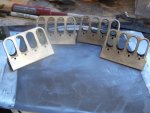Some words on the subject of reeds and cages, straight from the horses mouth and i quote
" OK,some thoughts and observations regarding reed sealing,leaking, cage lapping,cage surface,material,and wet and dry reeds.
First, realize that the Reeds open and close very fast, faster than you might think. A motor running at 4500 RPM is turning over 75 times a second, its reeds are opening and closing in half that time, because they remain closed on the down stroke of the motor, opening and closing at the beginning and the end of the upstroke. So, from their point of view they are opening and closing 150 times a second. They don't have much time to leak, and what we usually perceive as leakage, the mist coming from the carburetors, is not leakage at all , but reflux.Reflux is the fuel/air mix that escapes the crankcase at the end of the intake stroke as the crankcase begins to pressurize, before the reeds close.Lots of factors govern how much reflux takes place, the main factors are the weight and stiffness of the reeds the themselves,heavier metal reeds suffer more reflux than lighter composite ones,Our glass reeds usually weigh about 1/2 of their metal originals,helping them to open and close quicker...more in/less out.
As for lapping the cages, I recommend it. Usually a sheet of 400 paper, a little soapy water,a very flat surface a few minutes is all that's needed. Preparing the cage surface is important not so much for the sealing aspect but to provide a flat surface for the reeds to land on without damage. Realize the average reed leaf is probably around 1/3 of a square inch, case pressure is around 6 in.², resulting in about 2 pounds of force pushing each leaf shut at a cyclic rate of 2 to 300 times a second on a high-performance motor...not much time to leak…but even tiny flaws in the cage surface will quickly damage the perimeter of the reed leafs,that support that 2 pounds of pounding force.
Realize also these reed petals are very close to the spinning crankshaft , and do not always land flat on the face of the cages.If the surface of the cage is not smooth and hard the reed corners will dig into the rubber and ruin the surface,break the reed or both.This has become a major problem for Mercury motor built from 1996 on.
Wet and dry reeds, not much difference. Even dry reeds are lubricated by the oil from the crankcase that escapes back into the intake tract during reflux.
Chris,CCMS reeds "





















